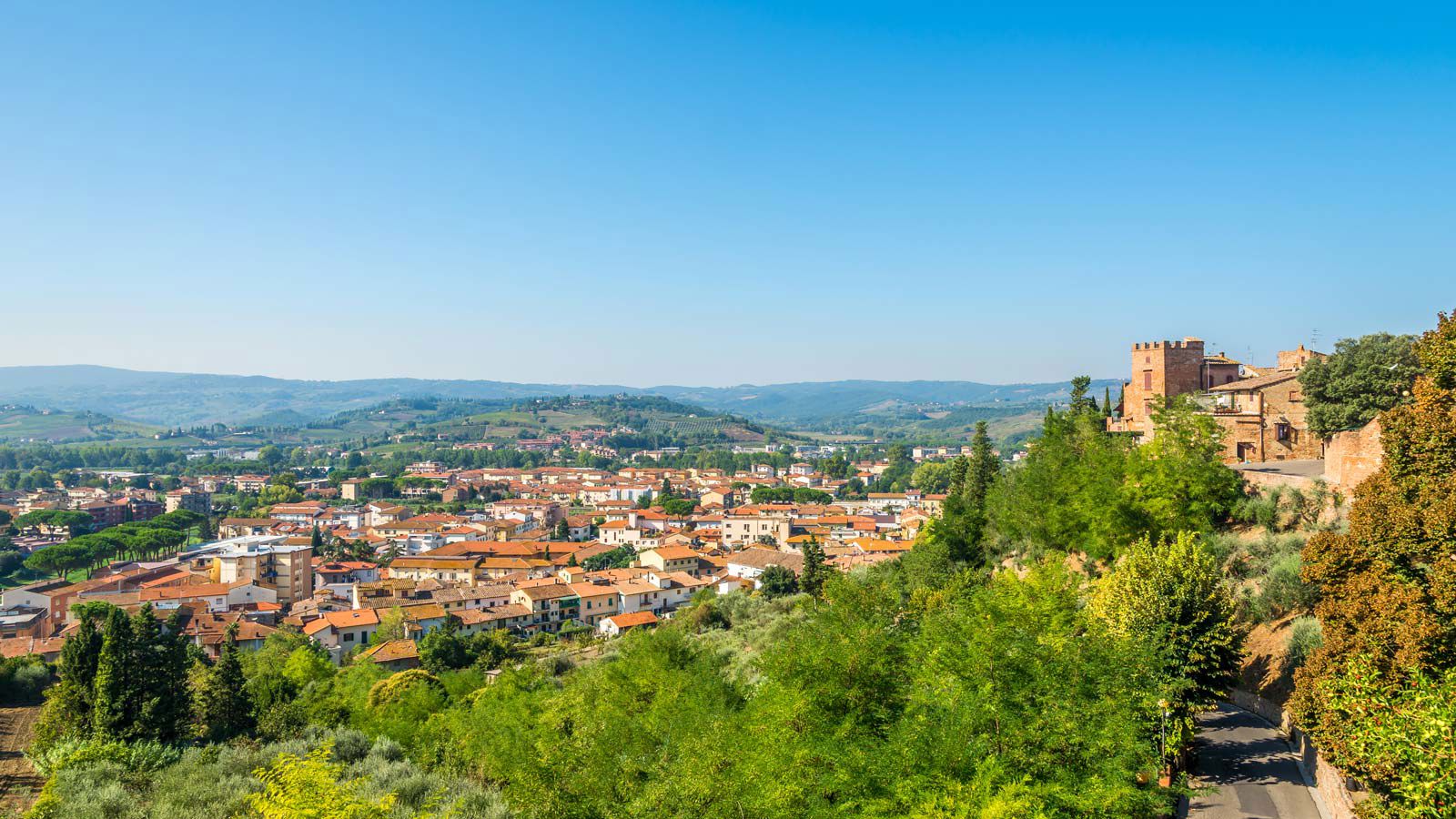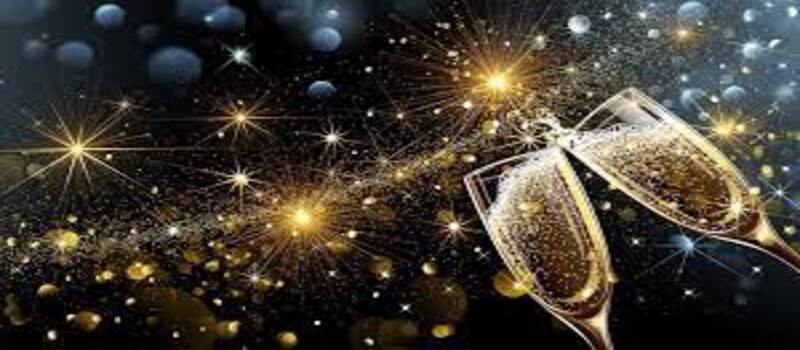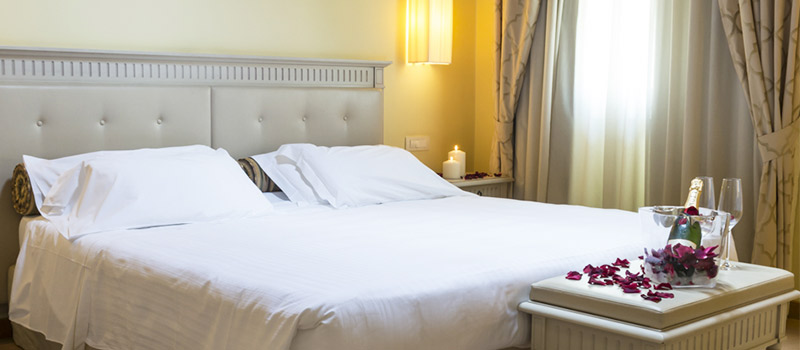PALAZZO PRETORIO
Il Palazzo Pretorio (The Praetor’s Palace) is one of the most important historical buildings of Certaldo Alto and it’s considered as its symbol. It lies at the end of Via Boccaccio, the main street of the village, from where it overlooks the entire hamlet.
The facade is made up by red bricks, the coat of arms of the Vicars of Certaldo, the bell tower with the clock, the loggia with its small courtyard and the staircase on whose top are the medieval defending posts in their typical square shape, widely spread in all of Tuscany.
The different and colourful coat of arms made of terracotta, marble and pietra serena (grey stone typically used in Tuscany for palaces and noble homes) represent the families of the Vicars who have ruled Certaldo through the centuries and who lived inside Palazzo Pretorio. Every coat of arms shows the dates of the beginning and end of such periods. Some of these coats of arms were commissioned to very important Florentine workshops, such as Bottega dei Bugiani and Bottega della Robbia, who left their specific mark in some of the decorations.
The front wall of the Loggia also shows some interesting frescoes: allegoric and symbolic scenes of Certaldo’s political life of the time, and even a coat of arms which the Medici family had painted. The Medici family also owned, for a period, the old water mill of the town, which is now become Hotel Certaldo. In the past, the Loggia was the designed place for public ceremonies and parades. Being in the very center of the main town artery, the population of the village could see and hear clearly the Vicar’s proposals.
There are many halls inside Palazzo Pretorio, each with its own purpose at the time: the Knight Hall, used for investigations, where the inscription reads ‘Listen to the other part and believe not’, which was also found in public buildings of San Gimignano.Then we can find the Hearing Hall, used for trials, the Prison, the private chapel of the Vicar, the Torture Room, to obtain confessions from the prisoners and the criminal prisons, where calendars made day by day by inmates are still visible carved in the stone walls. A prison for women was is also present in a separate part of the palace. Then it is also possible to see the Vica Hall, for the important ceremonies, the Vicar’s Private Quarters, the maids’ room and the foreigners’ room.
Nowadays Palazzo Pretorio, after careful restoration, is a beautiful and peculiar location which is often chosen for some of the most lovely weddings in Tuscany, amongst middle age and modernity!
STIOZZI RIDOLFI PALACE
As soon as we enter the medieval town we can find in front of us a large building in red bricks which takes up the whole block: it is Palazzo Stiozzi-Ridolfi, a remarkable example of Tuscan architecture of thE 14th century, virtually intact. It is possible to see the two main towers overlooking the streets with their typical square shapes, used in the past as defending posts.
The big entrance door is now shut, as the palace is now divided into private accommodations, but it is still possible to gaze through the big iron grated windows.
From here it is possible to see a wide courtyard, an elegant loggia with columns in red bricks and pietra serena, a well for rainwater and a fountain, everything recently restored.
In the past the courtyard was the place where the market took place, and most surely Giovanni Boccaccio used to go there, having spent most of his life in Certaldo until his death in 1375.
In the courtyard we can also find a small and deconsecrated chapel which was once private and showed some original frescoes. Noteworthy is also a small low relief portraying the face of a young man inside a blue circle.
The two-colour painting, the use of terracotta and the style of the artwork might indicate an original piece of Della Robbia, such as some of the coat of arms on the façade of Palazzo Pretorio.
You will be able to see this beautiful low relief from the two iron-grated windows overlooking inside the courtyard, or during ‘Mercantia’, the international street art festival during which the doors of the courtyard are open in order to host some of the shows. During this festival the very façade of this palace is used as a vertical stage by dancers, who perform hanging from the tower by the belt or coming down from the old windows, dressed in white costumes with wings, creating a magical and surreal atmosphere.
GIANNOZZI PALACE
Palazzo Giannozzi lies in front of Palazzo Stiozzi-Ridolfi, and is another of the important buildings of the town. More recent than the other palaces, Palazzo Giannozzi dates back to the Renaissance and has a particular structure, very wide and with a lovely panoramic terrace overlooking the modern part of the town. From here San Gimignano is also on the close horizon, as the Chianti hills. Palazzo Giannozzi has also been recently restored and hosts today some of the activities of Certaldo Alto: the Boccaccio Wine Bar, the restaurant Da Messer Boccaccio, the ceramic workshop ‘Artesia’ and the museum of woodworking ‘Beppe Chiodo’.
BOCCACCIO'S HOUSE
Boccaccio’s House is another of the symbols of Certaldo Alto, village where the poet and writer was born, spent most of his life and died. The house hosts now the museum dedicated to him, with a library of more than 3500 volumes of his works, different editions and translations.
The first historical records of Boccaccio’s house date back to 1375, when the poet, in his last will, leaves the house to his brother. From this moment there are no more news about the house until 1821, year in which Carlotta de Medici buys it and has a fresco painted portraying the poet. After Carlotta’s death the building becomes property of the State, which gives it to the cares of the Certaldo Pro Loco Association, that begins the collection of the manuscripts and the restoration of the facility. In 1944 the house is bombed and partially destroyed, but is restored in the following years, obtaining the aspect we can see today. It is an integral part of Certaldo museum centre, open to public for visits and offering the Room of the Poet, objects and furniture from the 14th century, the copy of Boccaccio’s headstone, the original shoes from the 14th century found after the WWII bombing, an historical-documentary exhibition about the poet and other information. Remarkable also the view from the house tower, from which it is possible to enjoy the panorama of the village and of the sweet slopes of Tuscan hills surrounding the area.
SAINT JACOB AND PHILIP CHURCH
The church of saint Jacob and Philip is a lovely and intimate facility in Romanesque style, dating back to the 12th century. Inside are kept the remains of Giovanni Boccaccio and the sainted Giulia. This small and lovely church is now chosen by many couples, Italian and foreigner alike, to celebrate their wedding ceremony. If you are looking for a wedding location, Certaldo Alto might be a wonderful choice! Thanks to the historical and ancient origins of the village, the Elitropia Association can provide with medieval clothing to rent for costumed weddings!
SACRED ART MUSEUM
Certaldo’s Museum of Sacred Art was founded in 2011 and is located inside the former convent of Augustinian monks. It is next to the Church of Saint Jacob and Philip, and together with Palazzo Pretorio and Boccaccio’s House makes up the Certaldo Museum Centre. The museum has 7 different halls hosting the art gallery, the goldsmithing gallery, church’s vests, sculptures and other interesting objects and historical artifacts concerning the life and religious activities of Certaldo in different times. In the latest months the museum is being extended bringing to the light the underground levels of the convent in order to create more museum halls. Not to be forgotten is also the beautiful outdoor colonnade!








